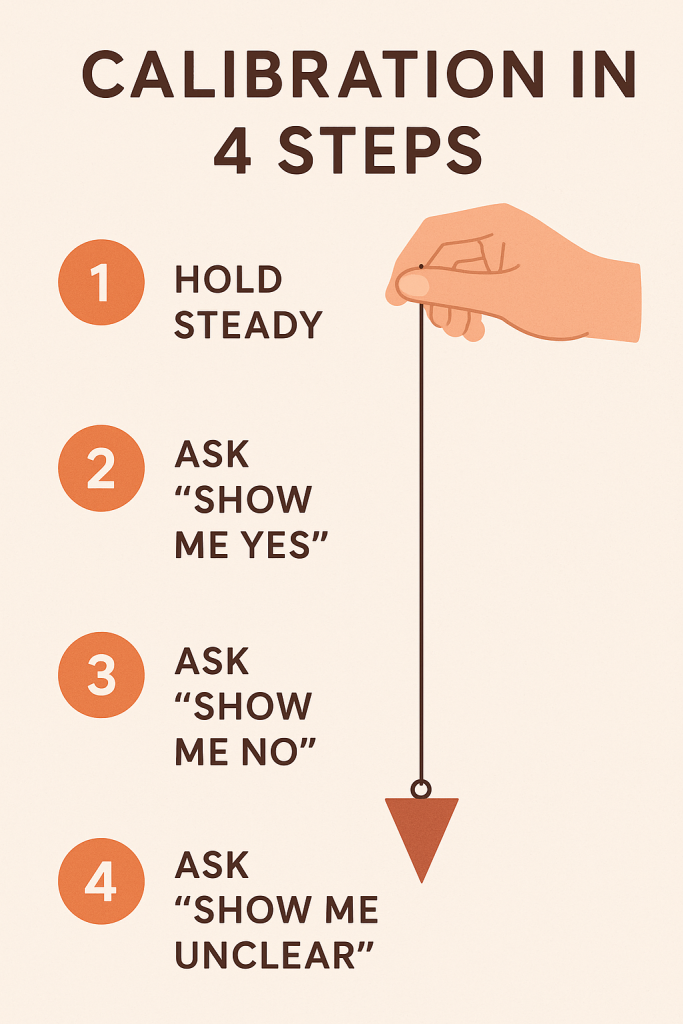Introduction: Why Pendulums Still Fascinate
Imagine standing in a quiet room, holding a small crystal suspended on a chain. You ask a question, and the pendulum begins to move—not dramatically, but with a subtle swing that feels almost alive. Is it your hand? Is it energy? Is it spirit? For centuries, seekers have turned to pendulums for answers, yet too often modern articles reduce this ancient practice to a flat yes/no gimmick.
The truth is richer. Pendulum readings are part art, part science, and deeply human. They weave together subconscious cues, energy flows, and psychic intuition in ways that can guide decision-making, healing, and self-understanding. This article goes beyond the basics to show how pendulums can open new doors in your personal and spiritual journey—complete with examples, rituals, and insights you won’t find in copy-and-paste guides.
The Dance of Physics and Spirit
The Science Behind the Swing
At its simplest, a pendulum is just an object suspended on a string, swinging in response to gravity. Physicists can predict its motion with neat formulas, but what fascinates both skeptics and psychics is the subtle role of the ideomotor effect. Psychologists explain that tiny unconscious muscle movements can create pendulum swings, revealing hidden thoughts and expectations.
A 2018 study published in Frontiers in Psychology found that traits like “transliminality” (sensitivity to subtle stimuli) predict how responsive a person is to ideomotor effects (PMC Study). This suggests that pendulum accuracy may be linked to personality—some people are simply more open to subconscious signals.
The Psychic Perspective
Psychics take this one step further. Instead of dismissing the ideomotor effect as “just muscle twitches,” they see it as proof that the body is a bridge between spirit and mind. The same micro-movements scientists measure can be interpreted as energy flows—your subconscious connecting with higher guidance. In other words: what psychology calls “ideomotor,” psychics call “intuition in motion.”
The Dual Dance
Think of pendulum readings as a dance between physics and mysticism. The swing is real, measurable, physical. But the meaning we draw—the archetypes, the guidance, the healing—belongs to the psychic realm. When you learn to appreciate both sides, the pendulum stops being a toy and becomes a tool.
Choosing and Calibrating Your Pendulum
More Than Just a Crystal on a Chain
Most beginners grab the prettiest pendulum they can find—often a rose quartz or amethyst crystal dangling from silver chain—and start swinging. While that works, the material and shape can dramatically influence how sensitive and accurate your pendulum feels.
Crystals like quartz, amethyst, or lapis lazuli amplify energy and resonate with specific chakras.
Metals like brass or copper conduct subtle vibrations, making them great for those who want crisp yes/no signals.
Wood creates a grounded, earthy energy, ideal for nature-based practices.
Glass or resin pendulums are neutral, perfect for those wanting minimal energetic interference.
The Pendulum Calibration Ritual

Before you start asking questions, you need to learn your pendulum’s language. Calibration is the process of discovering how your pendulum signals “yes,” “no,” and “uncertain.”
Try this simple practice:
Hold your pendulum steady and relaxed over your open palm.
Ask aloud: “Show me YES.” Note the direction of movement—forward/back, side-to-side, or circular.
Repeat with: “Show me NO.” Observe carefully.
Ask: “Show me MAYBE or UNCLEAR.” Sometimes the pendulum vibrates, spirals faintly, or doesn’t move at all.
Each pendulum—and each reader—may have unique signals. One psychic shared how her pendulum vibrated slightly for “unclear” answers, a signal she only discovered after multiple calibration sessions.
If you’re just starting, this Healing Sounds guide walks you step-by-step through beginner-friendly calibration.
Rotate, Experiment, Personalize
Don’t be afraid to own multiple pendulums and compare. You might find that your brass pendulum is perfect for financial questions, while a rose quartz pendulum resonates for relationship guidance. Think of them like musical instruments—each has its own tone, and some songs require a different instrument.
Asking the Right Questions
Why Wording Matters
The pendulum is not a mind-reader—it responds to the way you phrase questions. Vague or emotionally loaded phrasing can warp results. Asking, “Will I ever be successful?” is too broad; the pendulum may spin aimlessly. Instead, try: “Would focusing on creative work right now bring me success?”
Questions should be:
Clear and simple: “Should I take this new job?”
Time-specific: “Is today a good day to start this project?”
Empowered: “Would joining this community support my growth?”
The Ethics of Asking
Pendulum readings should never violate another person’s boundaries. Asking, “Is my ex still in love with me?” may give a swing, but psychically it crosses into their private energy. Better: “What can I do to heal from this breakup?”
Ethical guidelines for pendulum work are outlined in this Learn Religions guide, which emphasizes framing questions with clarity and respect.
Example: The Wrong Question, the Right Lesson
One reader shared how she asked: “Should I marry my partner?” The pendulum swung wildly, giving contradictory signals. Later, she refined it: “Would marrying this partner bring balance and growth to both of us?” The pendulum steadied with a clear response. The lesson: the pendulum reflects the precision of your own thinking.
Beyond Yes/No: Depth and Complexity
Unlocking the Full Vocabulary
Pendulums are often reduced to yes/no answers, but they can express much more. Advanced practitioners use dowsing boards, chakra maps, or custom charts to expand readings into multi-layered guidance. Instead of just “yes” or “no,” a pendulum can swing toward symbols, letters, directions, or numbers, giving you more nuanced insights.
Reading the Motion
Strong swing: A clear, confident answer.
Weak or hesitant swing: Uncertainty or resistance.
Circular motion: Energy clearing or neutral response.
Pauses or vibrations: An invitation to reframe your question.
One energy healer shared how she used a chakra chart with her pendulum. The pendulum consistently circled near the solar plexus area, pointing to confidence issues. After meditations and affirmations, the pendulum shifted to a smoother, stronger swing, reflecting her inner progress.
For a detailed guide to advanced pendulum techniques, Aerik Arkadian’s article explores posture, swing direction, and interpretive depth.
Psychic Practice vs DIY Exploration
The Value of Practicing Alone
Working solo with your pendulum builds self-trust. Daily sessions—whether for decision-making, journaling, or energy checks—train your subconscious to communicate more clearly. Many beginners report that after a month of consistent practice, the pendulum feels less like a tool and more like an extension of their intuition.
When to Seek a Psychic Guide
Psychic readers bring experience and a wider symbolic lens. While you may focus on yes/no answers, a psychic might see larger patterns—like noticing that all your “no” responses cluster around work-related questions, revealing resistance you hadn’t acknowledged.
One woman practiced pendulum readings for six months, always asking about career. She received mixed results and grew frustrated. During a psychic session, the reader noticed the pendulum’s inconsistency wasn’t about her technique—it was about her fear of success. With that insight, her pendulum responses grew clearer, and she found the confidence to pursue a long-desired promotion.
Blending Both Worlds
DIY pendulum practice teaches you the basics and helps you grow spiritually. Psychic guidance adds depth, perspective, and validation. Together, they create a balance of independence and wisdom.
Pitfalls and How to Avoid Them
The Common Traps
Pendulum practice seems simple, but beginners often stumble on the same issues:
Overthinking: Doubting every swing until you override intuition.
Fatigue: Trying to read when tired or stressed, which muddies results.
Emotional bias: Wanting a specific answer so badly that your micro-movements push the pendulum there.
Environmental noise: Drafts, shaky hands, or distractions interfering with the swing.
The Problem of Pendulum Drift
Sometimes your pendulum’s signals change—what once meant “yes” now looks like “no.” This “drift” can come from inconsistent grip or posture. To fix it, recalibrate: sit in the same position, relax, and re-ask your pendulum to show you each response.
Example: Fixing a False No
A practitioner kept getting “no” for every question, even when testing obvious answers like “Is the sky blue?” After recalibrating, she discovered she had been holding the chain at a different angle. Once corrected, the pendulum swung clearly again.
Rituals for Daily Life
Morning Alignment
Begin the day by holding your pendulum and asking, “What energy will support me today?” Pulling this small thread can give you direction, whether it’s courage, rest, or focus.
Evening Reflection
Use your pendulum for a gentle review: “Did I live in alignment with my intention today?” Journal the answers and notice patterns over time.
Weekly Energy Check
Many readers use pendulums with chakra charts to spot imbalances. For instance, if your pendulum circles weakly over the heart chakra each week, it might signal an emotional wound needing attention.
Keep It Light
Pendulum rituals don’t have to be long or elaborate. Just five minutes a day is enough to strengthen the dialogue between your intuition and your higher self. For structured beginner-friendly routines, this Healing Sounds guide offers simple practices you can adapt.
Real Stories of Transformation
Career Clarity
A teacher was torn between staying in her stable job or pursuing holistic wellness full time. Her pendulum consistently swung toward “yes” when she asked about launching her practice. Encouraged, she began part-time sessions and within a year, her wellness work fully replaced her teaching income.
Relationship Healing
One woman used her pendulum to ask about reuniting with an ex. The swing was hesitant and weak, signaling uncertainty. With guidance from a psychic, she reframed her question: “Would focusing on my healing bring me love sooner?” The pendulum responded with a strong yes. Six months later, she was in a healthier relationship—proof that the pendulum’s message was about her growth, not her past.
Creative Breakthrough
A writer facing blockages used her pendulum to decide between two storylines. At first, the pendulum wavered. When she refined her question—“Which idea will energize me the most?”—the pendulum swung firmly. That storyline reignited her passion, and the book became her most praised work.
These stories remind us that pendulums don’t dictate the future. They reflect your subconscious alignment and offer nudges toward what serves you best.
Conclusion: Trust the Subtle Signals
Pendulum readings are more than swinging objects. They are conversations between your body, your subconscious, and the energies around you. Science might call it the ideomotor effect, while psychics call it intuition in motion. Both are true—and together they explain why pendulums remain one of the simplest yet most profound divination tools.
If you’re starting, remember this: your pendulum is not a dictator, but a mirror. It doesn’t hand you answers—it helps you uncover the truth already waiting inside. Practice daily, refine your questions, and keep your heart open. Trust the swing. Trust yourself.
Pendulum Readings Frequently Asked Questions (FAQ)
1) What is a pendulum reading, in simple terms?
It’s a focused way to ask clear questions and observe a pendulum’s motion as a mirror of intuition and subtle energy.
2) Is the pendulum just the ideomotor effect?
Psychologists call micro-movements “ideomotor.” Psychics view the same phenomenon as intuition in motion. Both frames can be true.
3) How do I calibrate yes, no, and unclear?
Ask “Show me YES,” note the motion; repeat for NO and MAYBE/UNCLEAR. Recalibrate each session to maintain consistency.
4) Which pendulum material is best for beginners?
Quartz or brass are responsive and consistent. Try a few materials to see which produces the clearest, least hesitant motion for you.
5) How tight should I hold the chain?
Relaxed grip, elbow supported if helpful, chain length 4–6 inches. Tension or shaky posture can introduce noise.
6) What time of day gives better results?
When you’re rested and calm, many readers report clearer swings in the morning or after brief breathwork.
7) How do I avoid “pushing” the answer I want?
Ground first, release expectations, and ask neutrally framed questions. Journal both the answer and your emotional state.
8) Can I ask open-ended questions?
Use stepwise clarity: start broad, then narrow into specific, time-bound, empowered questions to reduce ambiguity.
9) Is it ethical to ask about other people?
Keep consent central. Ask what you can do, not what someone else feels or will do. Focus on your choices and alignment.
10) Why do my signals change over time?
Grip, fatigue, posture, or emotional charge can shift signals. Recalibrate and standardize your setup.
11) Can pendulums do more than yes/no?
Yes—use dowsing boards, maps, letters, numbers, or chakra charts for nuanced guidance beyond binary answers.
12) What’s a fast pre-reading ritual?
Three slow breaths, set an intention, calibrate YES/NO/UNCLEAR, then ask one precise question at a time.
13) How many questions per session is ideal?
Keep it short—5 to 10 clear questions. Long sessions invite fatigue and bias.
14) How do I phrase better questions?
Make them specific, time-bound, and action-oriented: “Would reaching out to X this week support my goal?”
15) Can I combine tarot and pendulum?
Yes. Pull tarot for themes, use the pendulum for clarifying details or sequence. Record both in a journal.
16) Why do I get mixed or hesitant swings?
The question may be unclear, the timing off, or you may be emotionally attached to an outcome. Pause, reframe, reset.
17) Does location matter?
Choose a quiet, draft-free space with a stable surface. Subtle air currents can affect motion.
18) What about protective or cleansing steps?
Light a candle, set boundaries, cleanse the space or the pendulum (smoke, sound, or intention) if that aligns with your practice.
19) How do I track accuracy over time?
Keep a simple log: date, question, answer, confidence (1–5), outcome. Review monthly for patterns and improvements.
20) Can pendulums help with health or legal decisions?
Use for personal clarity only. For medical, legal, or financial issues, consult qualified professionals and treat pendulum input as supplemental.
21) Why do results differ between pendulums?
Weight, material, and your energetic rapport can change responsiveness. Assign different pendulums to different topics if helpful.
22) What is “pendulum drift” and how do I fix it?
When signals slowly change due to grip or posture. Re-center, relax shoulders, recalibrate, and standardize your setup.
23) Can I read for others?
Yes—obtain consent, set ethical boundaries, and ask questions focused on supportive actions rather than control or intrusion.
24) How do I use chakra charts?
Calibrate, then hover over the chart. Note strength, direction, or hesitancy above each center; follow with meditation or energy work.
25) How do I reset after an emotionally charged question?
Close your eyes, breathe, touch the table with the pendulum tip to still it, and re-calibrate before continuing.
26) What if I’m still not getting clear answers?
Reduce session length, simplify questions, try a different pendulum or time of day, or add a brief meditation beforehand.
27) Can a psychic make my readings clearer?
Experienced psychics bring symbolic layering and pattern recognition that can reveal blind spots and refine your process.
28) How soon should I act on an answer?
Pair the answer with one small, low-risk step within 24–48 hours. Action builds discernment and reduces second-guessing.
29) How do I keep sessions grounded, not superstitious?
Blend intuition with reason. Use journals, review outcomes, and, where appropriate, seek expert advice alongside readings.
30) What’s the best beginner routine?
Daily 5 minutes: breathe, calibrate, ask one empowered question, log the answer, and take one tiny aligned step.





This article provides a fascinating insight into the use of pendulums in psychic readings. The historical context and practical applications, such as finding missing items and determining the sex of a baby, add a layer of credibility and intrigue. It’s particularly interesting to learn that even Albert Einstein believed in the potential of pendulums to provide answers. For anyone curious about exploring divination tools, this piece offers a comprehensive introduction.
Pendulum readings appear to be a versatile tool in the realm of psychic practices, capable of addressing various aspects of life. Understanding the intricacies of interpreting pendulum movements is key to their utility.
It’s intriguing that pendulums can be influenced by spirit guides to provide answers. The method of interpreting their movements appears to rely heavily on the skill and experience of the psychic.
The idea that Albert Einstein believed in the efficacy of pendulums lends an intriguing scientific angle to the practice. It would be interesting to explore any empirical studies conducted on this subject.
The concept of using pendulums for divination raises interesting questions about the nature of the answers obtained. It would be beneficial to understand more about how the accuracy of these readings is validated.
The use of pendulums in divination is quite fascinating. It seems that these tools have a broad range of applications, from locating objects to determining personal paths. The historical context adds an additional layer of credibility.
Comments are closed.